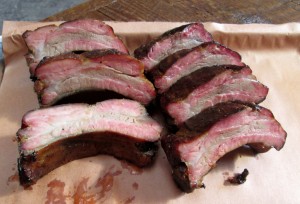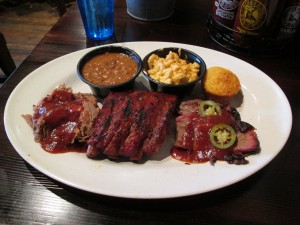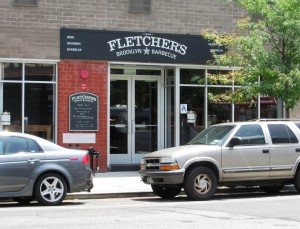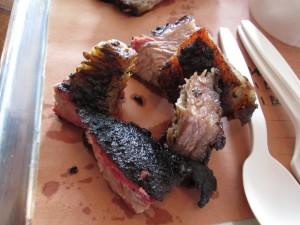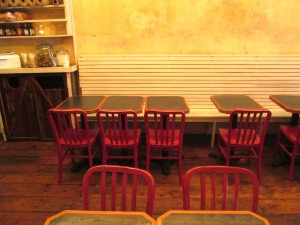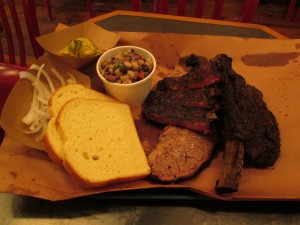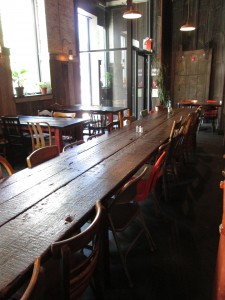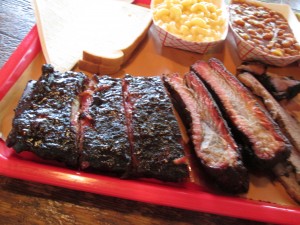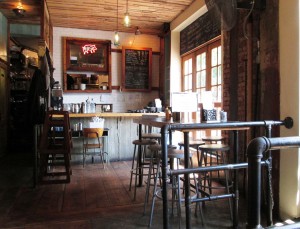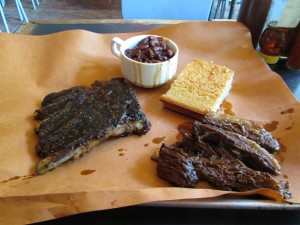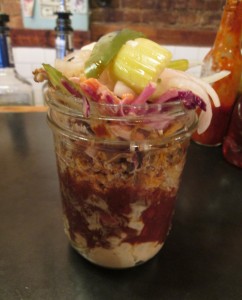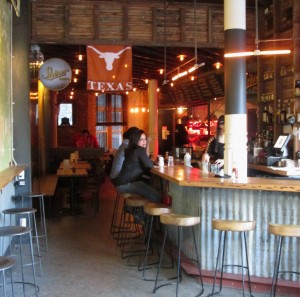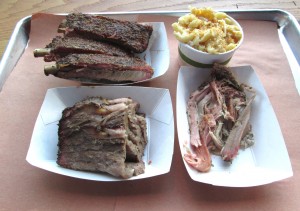(by Corbo Eng)
If, ten years ago, one would have guessed that barbecue would become one of the hottest, trendiest, most sought-after foods in New York (and with Brooklyn positioned, with all due respect to Manhattan, at the epicenter), it would have been hard to imagine.В Barbecue?В Identified with places like North Carolina, Texas, Memphis, and Kansas City, barbecue conjures up small town charm, open spaces, rustic simplicity, and a long, undeviating tradition.В It is everything New York City supposedly is not and does not have.
However, maybe, barbecue took hold in Gotham as a counterpoint to or antidote for the gastronomic stuffiness that shapes the city’s image (particularly, as it relates to Manhattan).В And, maybe, with barbecue being one of AmericaвҖҷs most original food traditionsвҖ”a sort of first frontier that needed to be conquered, New York, the culinary capital of the country, had to get in on the act as well in order to tame its own psyche.
With BrooklynвҖҷs riseВ in recent years as a genuine food destination, coinciding with barbecueвҖҷs emergence in the Big Apple, it is not surprising that it has become home to many of the best barbecue restaurants in the city.В Indeed, the boroughвҖҷs promise of lower operating costs, larger, more available space, and a thriving dining scene all benefit purveyors of barbecue just like it does other Brooklyn-bound restaurateurs who have declared Brooklyn “Open for Business.”
In fact, BrooklynвҖҷs newest barbecue restaurant, Hometown Bar-B-Que, is a likely testament to all of those aforementioned blessings.В Tucked away in Red Hook, in a renovated warehouse across from Fairway Market, Hometown Bar-B-Que boasts the kind of enormous space that would be hard to secure in ManhattanвҖ”with not one but two dining rooms, two bars, and enough repurposed wood, exposed brick, and rustic decor to please any Brooklynite’s Texas-inspired sensibilities.
The food too is large: huge slabs of blackened brisket, whole chains of baby back ribs, beef ribs the size of meat cleavers.В At the service counter, at the rear of the cavernous main hall, the cooks and pitmaster, Bill Durney, are busy tending to those meatsвҖ”slicing brisket to order or plopping down ribs and sides on neat metal trays while the usually meandering line, seemingly, never shrinks one bit.В Enthusiastic customers from Red Hook and the rest of Brooklyn (and probably from Manhattan too), sipping drinks from the bar and eager to enjoy some good ‘cue, narrow down their choices as they pass away the time in lineвҖ”choices, to their benefit, that are time-honored staples culled from Texas BBQ lore.
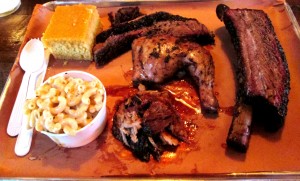
(clockwise): brisket, beef rib, pulled pork, and jerk chicken (center) with mac & cheese and cornbread
Brisket is king; and, at Hometown, it boasts a distinct pedigree since Bill Durney learned his craft from Wayne Mueller of Louis Mueller’s Barbecue in Taylor, TexasвҖ”a Central Texas BBQ institution that’s been meticulously smoking brisket and other meats since 1949.В Hometown’s brisket would seamlessly fit in at Louis Mueller’sвҖ”based on appearance and taste.В Durney’s brisket, smoked over oak wood, is moist and luscious; so are the gargantuan beef ribs.В The baby back pork ribs (a rare cut, to be sure, in Brooklyn where St. Louis style ribs are almost universally favored), however, deviate from Texas tradition; but, with their beautiful smoke rings and sweet overtones of cherrywood, are delicious too and are among Brooklyn’s very best.
The pulled pork too is outstanding.В Whereas it can easily be dried out, the pork here is soft and delicate.В The texture is great.В A vinegary spice rub finishes off the shredded pork and adds a depth to it that truly raises it to the highest level.В It would be hard to find better pulled pork anywhere in Brooklyn.В Even the cornbread is excellent.В Getting it to be moist and resilient is most of the work.В Adding bits of corn and jalapeГұos to it is just over-the-top…and utterly delicious.
Dinosaur Bar-B-Que’s Brooklyn outpost, the latest in chef and owner, John StageвҖҷs popular New York-based chain, now also boasts, like Hometown Bar-B-Que, a mammoth location in BrooklynвҖ”in a former warehouse on Union Street in Gowanus where soldering smoke or chemical fumes, no doubt, once penetrated the air.В It literally gives Dinosaur, who already has name recognition and loyal fans, a huge foothold in the Brooklyn barbecue scene; and, obviously, Stage and his staff are taking full advantage of this by servingВ throngs of customers both day and night.
The menu is expansive too with all of the main players representedвҖ”beef brisket, pork ribs (cut St. Louis style), pulled pork, chicken (including wings), burgersвҖ”less common items like catfish and, additionally,В an array of sides and specialty sandwiches to choose from.В As a customer, it can be overwhelming to process all of the choicesвҖ”which features items separately or in various combo platters.
The Tres NiГұos combo offers a sampling of pulled pork, pork ribs, and beef brisket with two sides and a piece of honey hush cornbread and serves as an accommodating entry point.В To dive into this platter, served on a huge oval plate, is to indulge in a holy trinity of barbecueвҖ”featuring the most seminal cuts of meat.В The brisket, served with a generous slathering of barbecue sauce in a style reminiscent of Kansas City, is lean and topped with slices of plucky jalapeГұo peppers.В The sauce is rich and tangy with a bit of a kick.В The pork ribs here, glazed and possessing intermittent charring, have a reddish barkвҖ”which,В turned to the side, reveal a pleasingly pink smoke ring.В The ribs are more moist and tender than not and mostly sweet (in little agreeable notes).В The pulled pork, married to the house barbecue sauce, is the best of the three вҖңniГұos.вҖқВ It is skillfully prepared, shredded into compliant, supple strands, and are undeniably good.
FletcherвҖҷs, another barbecue purveyor in GowanusвҖ”however, on a much smaller scale, serves as competition a few blocks away on a seemingly neglected industrial stretch of Third Avenue.В There, behind a spartan and undistinguished storefront (but, whose presence enlivens the generally gloomy neighborhood), owner, Bill Fletcher, and Matt Fisher, the pitmaster, embrace an eclectic style that is not uncommon in the Brooklyn barbecue sceneвҖ”serving, for instance, burnt ends (a Kansas City favorite and a hallmark of that city’s barbecue culture), sauceless slices of brisket (reminiscent of Central Texas), dry ribs that might very well fit in at a barbecue joint in Memphis (minus the final dusting of spices), and even, when it first opened, a Chinese-inspired char siu pork shoulder smeared with hoisin and soy sauce that might, very well, have fit in at a trendy Asian-fusion restaurant in a hipper part of the borough.
The burnt ends, which aren’t featured or spotlighted at most barbecue joints in Brooklyn, are, in fact, a must-order when dining at Fletcher’sвҖ”for their rarity and for their excellent execution.В Gleaned from the crusty, charred point of the brisket, these little, beefy cubes are disconcerting at first glance.В They’re blackened to the point of blueness, broken, and look like discarded scraps destined for the trash can.В However, once consumedвҖ”with or without reluctance, the burnt ends impress with how moist and tender they are.В They are fatty in just the right places.В Eating them, without the interference of bones or the need of tearing or shredding (as might be required with brisket) is almost like tossing popcorn nuggets into one’s mouth.В One by one…in a flash, they are gone.В Indeed, they are deliciousвҖ”standing out for their robust, smoky flavor.
Over at BrisketTown a few miles away in Williamsburg, Daniel Delaney, a native New Jerseyan and former street food podcaster, has quickly established a reputation as a fastidious and obsessive devotee of Central Texas barbecue.В Having honed his craft under the influence of Wayne Mueller of Louis Mueller’s and Aaron Franklin of the cultishly popular Franklin Barbecue in Austin, Delaney is loyal to the Central Texas tradition.В He’s not interested in injecting his personal take on barbecue or tweaking things for the sake of barbecue evolution.В His devotion has, in no uncertain terms, cleared a straight and narrow path where deviation from tradition is frowned upon and where established methods and practices rule the day.В In fact, if it were not for the curiously bare walls that signify nothing particularly and the dining furniture, looking as if were salvaged from a Panera Bread restaurant, there might not be any indication (except for the 24 hour drive), when dining at Delaney’s restaurant, that one had not been blindfolded and taken to a BBQ joint in Lockhart, Texas (the holy city of ‘cue itself).
However, once ready to order, there is little confusion about what’s going on.В Lovingly hand-carved and set onto butcher paper meat market style, the offerings of meat at BrisketTown takes center stage to reveal that something special, despite its bland interior, is definitely taking place.В BrisketTown’s holy trinity consists of brisket (as the restaurant’s name indicates), pork ribs, and beef ribs (as it would be in Texas)вҖ”huge ribs like something ripped off a prehistoric dinosaur carcass.В All of the meat is painstakingly smoked with minimal seasonings, little if any basting, and the patient companionship of smoke and time and served without barbecue sauce in grand Central Texas fashion.
The pork ribs, kissed by salt, black pepper, cayenne, and a gentle maple syrup reduction, are tender, pull-off-the-bone, and decadentвҖ”with its sweetness tamed by oak.В The namesake brisket, which would be the centerpiece of any Central Texas barbecue joint, is rubbed simply with salt and black pepper and lovingly smoked to perfection.В Once sliced to order, the brisket isВ limp butВ appropriately firm, soft and rapturous, andВ seductively oozesВ the love that transformedВ it during itsВ hours of smoking.
BrisketTownвҖҷs beef rib, which some may regard as an afterthoughtвҖ”considering that the brisket and pork ribs are more familiar cutsвҖ”is not to be missed.В Given its size, it certainly can be shared by two or be consumed by one (with most, as leftovers, on the next several days).В But, diners should not be intimated.В The huge mound of flesh clinging to the rib bone (the very kind of rib bone that, by the way, serves as the handle on the restaurantвҖҷs front door) may be daunting and appear tough (given its size), but it is not.В The meat is anything but that and is just utterly sublimeвҖ”pull-off-the-bone tender with a peppery, crustyВ finish and a rich flavor that comes from just the right amount of fat (which has mostly rendered off and which offers just the right amount of melt-in-the-mouth goodness).В Pouting nodulesВ of sticky collagen only adds to the fun.В Eating food like this is what confirms the glory and the power of barbecue.
If a side is in order, the potato salad is first rate.В It is served in a heaping moundВ and is robust, firm yet creamy (almost like potato ice cream if there were such a thing).В The Texas caviar, which is a salad of black beans, black eyed peas, and navy beans, provides a bright counterpart to the onslaught of meat.В Mixed with cilantro, bell peppers, jalapeГұos, and jicama, the combination is herbal and distinctвҖ”with a citrusy (lime) dressing that binds the ingredients together.В The complimentary housemade pickle slices and onionsВ are not to be missed either.
Near the Williamsburg/Greenpoint border, MableвҖҷs Smokehouse & Banquet Hall upholds WilliamsburgвҖҷs status as a barbecue destination.В There, the husband and wife team of Jeff Lutonsky and Meghan Love have (no pun intended) lovingly transformed a former warehouse, with their own labor,В into a roadhouse replica.В Warm, brown tones and reclaimed wood create a familiar aesthetic appeal.В Long communal tables, made from repurposed planks, run in parallel rows in the dining room as sheets of light wash in from the large windows facing the street.В However, the best feature may be the collection of mismatched chairsвҖ”mostly wooden ones that posessesВ an array of different hues andВ designs.В Occasional molded plastic or metal folding chairs are thrown in for good measure.
In terms of its food, Mable’s leans on the styles of Northern Texas and, of course, Lutonsky’s home state of Oklahoma.В The Sooner state’s influence is exemplified in such items as “hot link” sausages.В A more important influence than the state itself, perhaps, is Mable herself (Lutonsky’s grandmother) who lends her name to her grandson’s restaurant and whose recipes are the restaurant’s foundation.В Those recipes are undoubtedly time-honored and time-tested and, of course, secretively guarded.В They, however, are manifested in the pulled pork and brisket (two staple items); but, it’s the pork ribs that, arguably, steal the show.
Smoky and surprisingly delicateвҖ”despite their hefty appearance, these ribs exhibit an exacting blend of sweetness and spiceвҖ”no doubt a marriage between cayenne pepper or paprika and some sort of syrup or brown sugar that gives the bark its pleasing mahogany finish.В But, who knows?В It’s a secret recipe, right?В The ribs, also, are so pull-off-the-bone, without being fall-off-the-bone and overcooked, and so moist and tender, that they cannot be the simple result of dumb luck or chance.В Grandma Mable is no rank amateur.В Real knowhow and devotion are at work.В The ribs may be BrooklynвҖҷs bestвҖ”or, at least, very near the top.В They are that good.
Of course, Park Slope is not to be left out of the picture.В Although it does not boast as many barbecue restaurants as Williamsburg (or as much hipster cred just yet), it does have one noteworthy entryвҖ”Fort Reno BBQ.В Located on Union Street (at the very edge of Park Slope and, interestingly, just a block away, across busy 4th Avenue, from Dinosaur Bar-B-Que), Fort Reno is the latest project from Jacques Gautier who is the chef and owner at Palo SantoвҖ”where Gautier offers an eclectic mix of Caribbean and Latin American inspired food.
Given his culinary background and experience at Palo Santo, it is no wonder that some of Chef GautierвҖҷs magic dust would rub off on the barbecue at Fort Reno.В This is most evident in the St. Louis style ribs on the menu.В Not only are the ribs exceedingly moist and tender, but its distinctive taste, which separates it from its competitors, leaves one wondering what went into their making.В The flavor of the crusty, dark exterior bark is seductive; and, with lips smacking and taste buds dialed up, one may discern the subtle notes of chili and chocolate, which, no doubt, is due to Gautier using a rub that mimics a Mexican mole (sauce)вҖ”such as mole poblano.В Another bite may reveal the faint hint of coffee that seems to be there.В With another bite, one may be left shaking oneвҖҷs head and wondering if some Chinese bean paste or if brown sugar, cinnamon, and paprika are not at play as well.В In the end, the pork ribs are just flat out delicious, complex, and special.
In addition, the brisket is outstanding as well.В It too is unlike what is served at other restaurants.В Cut into thick, block-like slabs, the meat has a gorgeous texture that suggests that it might have been smoke braisedвҖ”that is, in a pot of hot broth set inside a smoker, which allows the meat to bathe in a smoky liquid for hours on end until it is tender and ready to eat.В That it is cut from the point of the brisket and left with some necessary fat makes the already juicy slabs of brisket all the more decadent and beautiful.В It is just superb.
Of note, also, is a novelty dish called, the вҖңHot Mess.вҖқВ It consists, essentially, of the restaurantвҖҷs best sides servedВ together in a Mason jar.В The individual sides are bravely piled on top of one another to create a layered whole (like a parfait)вҖ”with the composite end result literally bursting out of the mouth of the jar.В A smattering of sea shell mac & cheese serves as the foundation with baked beans as the next level.В Then, there is a film of corn bread and some pulled pork on top of that.В The Hot Mess is finished with a layer of Cole Slaw and topped with spicy pickled veggies (which includes cucumbers, onions, carrots, and red cabbage among others).
Once scooped out with a spoon, the sides and all of their flavors and textures intermingle.В It worksвҖ”but just barely.В The sharpness of the pickled veggies valiantly carries the dish as everything else is either obliterated (such as the corn bread) or squished together into a muddiedвҖҰwell, mess, frankly.В If the dish were a suicidal man walking on the ledge of a building, forty stories from the street, it is only pulled back from a fatal fall by the slimmest of margins.
Nearby, in Prospect Heights, the recently opened Morgan’s BBQ follows a more traditional path.В Here, pitmaster, John Avila shuns extraneous influences like whimsical coffee grinds or Mexican mole and sticks to Texas protocol.В Perhaps, the giant Texas Longhorns banner hanging in the dining room is a dead giveaway.В Avila, like Bill Durney of Hometown Bar-B-Que, is Texas trained; but, in Avila’s case, it was in food-crazed Austin where he worked under Aaron Franklin, the guru of the Central Texas barbecue scene that also left such an imprint on Daniel Delaney of BrisketTown.
It seems Franklin, as boss and mentor, has taught Avila well.В Who would doubt it after sampling Avila’s handiwork?В At first glance, the main protagonists at Morgan’s doesn’t necessarily catch one’s eye.В The color of the meats seem slightly dull; and, with the light from the patio hitting them at a certain angle and the loud music preoccupying diners, the ribs and brisket even appear dry.В The pulled pork looks disappointingly stringy.В But, how the eyes can deceive!В One’s tastebuds know in the end.
In fact, the ribs are amazing.В The meat is pull-off-the-bone tenderвҖ”with a very peppery bark that accentuates what’s under it.В The ribs even have a mysterious fattiness to them (but without any noticeable fat to give that effect).В It’s a great added nuance to already brilliant ribs, which are clearly transformed by smoke and unequivocally delicious.В The brisket and pulled pork also possess this qualityвҖ”of being transformed (the brisket especially).В It’s appearance, characterized by its being cut into squares and its grayish hue, belies the fact that it is utterly first-rate.В Striations of fat line the squarish pieces, which are sliced rather thinly.В The mouthfeel is warm and smooth; and, once devoured, the flavor is forthright and just intensely smoky.В Diners, shaking their heads sheepishly in dismay, may confess that the brisket here is the best in Brooklyn.
At the moment, BrooklynвҖҷs bastion of barbecue restaurants is a legitimate calling card in the boroughвҖҷs growing dining scene; and, the emerging BBQ scene, based on number of purveyors alone (and, certainly, based on the quality as exemplified by Brooklyn’s best) already rivals that of those in the hallowed small towns across the country where barbecue has been traditionally embedded.
Who knows?В With time, the not-so-good barbecue in Brooklyn may get better; and, the good may become great…and the great, perhaps, even greater still.В The mix of styles, as wellвҖ”although favoring dry rubs and the exclusion of sauceвҖ”may have Brooklyn looking toward Texas or, even, Memphis.В But, there may yet be a Brooklyn style (or, a broader New York style) of barbecue in the future once time allows habits to form, trends to blossom, and traditions to become part of the daily fabric.В That will take time, for sure.В But, in the meantime, the present state of barbecue in Brooklyn is very healthy; and, its evolution is very much worth watching.
Copyright 2013 (Corbo Eng). В All Rights Reserved.
All photos by Corbo Eng.


